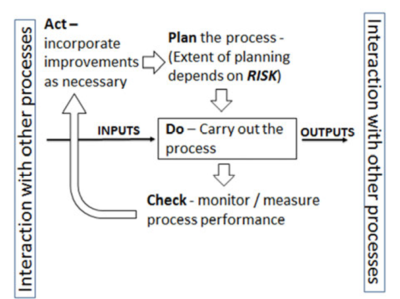Quality management principles
| Quality management principles |
|---|
| See also |
Quality management principles are basis of philosophy for the ISO 9000 standards since 2000 amendment. These principles are a link between ISO 9001 and Total Quality Management. Top management can use these principles to improve the functioning of the organization. Principles are as follows:
- Customer focus,
- Leadership,
- Engagement of people (before ISO 9001:2015 - involvement of people. See references at the end to understand the difference),
- Process approach,
- System approach to management (removed in 2015 issue),
- Improvement (before 2015: continual improvement),
- Evidence-based decision making (before 2015: Factual approach to decision making),
- Relationship management (before 2015: Mutually beneficial supplier relationships).
Customer focus
The customer focus is important when:
- purchase is not one time only,
- good relationships are more important than short term sales,
- product can be customized,
- customer doesn't know the product
To implement customer focus organization should:
- analyse, evaluate, predict and understand needs and expectations of customers
- establish objectives in relation to customer's needs and expectations
- communicate knowledge about customer within the organization
- develop customer satisfaction measuring system
- maintain communication with customer
- react to information from customer
- increase participation of customer in processes
Quotes about customer focus:
- Customer focus is not something that just happens. It has to be planned, implemented and should be rewarded[1]
- Customer focus means adoption of his point of view[2]
Leadership
Rules of leadership:
- Change the preferences of employees, don't force the execution of orders
- If you use authority, it wears out. Otherwise - it grows.
- Leadership is not hierarchy, the position in organization is not relevant
- Tools: implementation of the mission, consistency of the organization, managing conflict, building organizational culture
Leaders should establish a unity of purpose and set the direction the organization should take and create an environment that encourages people to achieve the organization's objectives. In practice, this means:
- create a vision of the company by managers,
- determine priorities for development,
- determine the value of targeting the market,
- establish policies and objectives compatible with the objectives of the organization,
- planning,
- establish internal communication and taking care of it,
- ensure proper working conditions,
- assist employees in their development,
- ability to understand and respond to changes in the internal environment
Quotes about leadership:
- Today we have too much leading. Leaders become cheerleaders [3]
Engagement of people
Employees at all levels are the essence of the organization. Organization should encourage the involvement of people and help them to develop and use their abilities for the benefit of the organization. The involvement of the people can be increased by:
- taking appropriate motivational action,
- creating an appropriate culture of the organization,
- the using of post permissions,
- the using of collaborative working methods,
- ensuring proper internal communication.
Trust has tremendous impact on engagement of people. Employees are more willing to engage if they have trust in managers. The trust is being built for years, but it can be lost in a second.
Process approach
Organization is more efficient and effective when use a process approach. Organization should use a process approach to manage activities and related resources. To achieve this:
- properly divide the organizations on the processes,
- define the responsibility for each process,
- designate the owner of the process,
- determine methods to measure the effectiveness of the process.
The figure on the right shows process approach using PDCA cycle. This figure shows process approach very clearly. Unfortunately it wasn't attached to final version of the standard.
See more about process approach in: Process.
System approach to management
This principle was removed in ISO 9001:2015, however it is still important. Even the ISO 9001 title contains word "system".
The effectiveness and efficiency of the organization in achieving the goals increases when interrelated processes are identified, understood and managed as a system. Organization should be regarded as a system of interrelated and interacting processes. Individual processes should be tailored to the goals of the organization which is the satisfaction of all parties (owners, employees, customers, communities, suppliers, partners).
See more about system approach in: System.
(Continual) Improvement
Organization should make a permanent commitment to continually improve their overall performance. It should be:
- establish mechanisms for continuous improvement,
- establish a system to evaluate progress in achieving the objectives,
- evaluate the results obtained according to established criteria,
- provide methods and tools to solve problems and improve processes.
See more about continual improvement in: Continuous improvement.
Evidence-based decision making
The organization performs better when their decisions are based on facts. The organization should base decisions on the analysis of factual information and data. It can use following methods:
- benchmarking,
- trend functions,
- statistical process control,
- key performance indicators,
- procurement procedures.
Relationships management
The organizations depend on their suppliers and other business partners who help create value. They should maintain a mutually beneficial relationship in order to achieve their objectives. They should share the knowledge, experience, and even to provide specific support. This may prove to be beneficial for all parties. This principle can be implemented through:
- creating of strategic links to implement common projects or processes,
- ensure the involvement of suppliers in defining requirements for products and processes,
- inform suppliers about the development.
References
- Leadership (Wikipedia)
- Engagement vs. Involvement
- Li JH (2003) Total quality management principles and practices in China, International Journal of Quality & Reliability Management, 20:9
- Rao SS, Ragu-Nathan TS, Solis LE (1997) Does ISO 9000 have an effect on quality management practices? An international empirical study, Total Quality Management, 8:6
- Karapetrovic S., Casadesus Fa M., Heras Saizarbitoria I., What happened to the ISO 9000 lustre? An eight-year study, „Total Quality Management” 2010, Vol. 21, No. 3
Author: Edyta Gołąb

